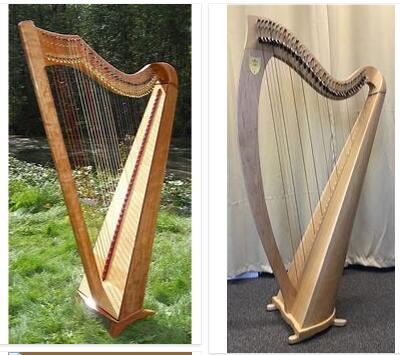According to abbreviationfinder, the harp is a plucked string instrument made up of a resonant frame and a variable series of strings stretched between the upper and lower sections. The strings can be plucked with the fingers or with a pick (or plectrum). There are several types standing out in popularity, in addition to the classical harp, currently used in orchestras, the Celtic harp and the Paraguayan harp.
History
The harp is a plucked string instrument, its origin is very old, of which today there is a modern version (double action harp), from the beginning of the 19th century.
If the central C of the piano – the C between the upper staff (in the treble clef) and the lower staff (in the key of F) – is considered to be C 4, then the range of the modern harp ranges from:
- he yes 0
- the sun # 7
It is widely used in the orchestra and less in chamber music, solos and for the accompaniment of voices.
The harp strings, in their basic position, give the C- flat major scale (which, for practical reasons, is called the B major scale. Each string can be modified using seven pedals. Despite the action of These pedals, the basic tuning of the harp is diatonic. A chromatic harp (giving a chromatic scale) was used in the 19th and early 20th centuries, other simpler and smaller harps, based more or less on older models, are used. They are found and used to accompany folk music such as the Aeolian harp.
Appearance of the orchestral harp
The medieval harp was diatonic, while the modern harp, on the contrary, was born with the first attempts at chromaticism that the evolution of Western music demanded. The first attempts came from the workshops of Irish luthiers (instrument makers) in the 16th century who provided the harp with a double row of strings. In the 17th century a third row was added, the 1st and 3rd row were diatonic (29 strings each row) while the 2nd row, with 20 strings, was reserved for semitones.
In the middle of the 17th century, some Tyrolean builders invented the hook harp, with which it was possible to stretch the string and make it a semitone higher. At this time there were many mechanisms incorporated to raise the tone, but all operated manually, so it had to be done before starting the performance.
At the end of the 17th century, a Bavarian luthier (from southern Germany) made the first harp with pedals that, located on both sides of the instrument stand, were attached to the fixed hooks of the console by a transmission system. The pedals were 7, and they corresponded to the 7 degrees of the musical scale (do, re, mi, fa, sol, la, si). For this instrument Wolfgang Amadeus Mozart wrote his Concerto for flute and harp in 1778.
Harp types
There is a lot of types:
- the classical harp, currently used in orchestras,
- the celtic harp and
- the Paraguayan harp.
The harp in music
The harp is widely used in academic music, usually for effects such as glisando or arpeggios. In Italian and German opera it is used for romantic arias and dances, such as the ” Waltz of Musetta ” in La bohème . French composers such as Claude Debussý and Maurice Ravel composed concertos for harp and chamber music that are still being performed.
During the 19th century, the French composer and harpist Nicolas Bochsa composed hundreds of pieces of all kinds (opera transcriptions, chamber music, concerts, operas, methods for the harp).
The 20th century harpists Henriette Renié and Marcel Grandjany composed many solos and chamber pieces that feature in the harp repertoire.
Modern composers use the harp frequently because the pedals on a concert harp allow for all kinds of scales and effects sounds, although some modern pieces require a lot of use of the pedal.
Alice Coltrane is known for introducing this instrument to jazz bands .
In Latin America, the harp is an instrument used in the typical music of several countries, including Chile, Colombia, Mexico, Paraguay (in the galopera genre) and Venezuela (in the joropo genre).
